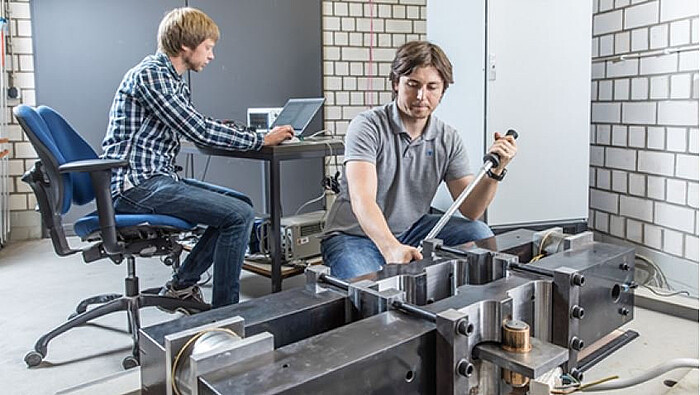

For many years, we at the Institute for Steel Construction have been engaged in research and teaching on the classical topics of steel construction, such as the load-bearing behaviour and stability of structures made of steel and steel composite structures, bridge construction and the behaviour and service life of connections.
But also special and new questions challenge us.
For more than 20 years we have been researching the load-bearing structures of onshore and offshore wind turbines in order to create a basis for the efficient generation of regenerative energy to protect the climate. The load-bearing and fatigue safety of bolted and welded joints as well as of hybrid joints (grouted joints) are just as much the focus as the design optimization of structures and automated manufacturing and monitoring processes.
Typical for our research is a close interaction of numerical investigations and experimental validation. For this purpose we have laboratory equipment with testing machines for static, dynamic and thermal loads as well as modern measuring and analysis equipment at our disposal. The experimental component has recently been strengthened by the Test Centre Support Structures Hanover (TTH).
For many years, we at the Institute for Steel Construction have been engaged in research and teaching on the classical topics of steel construction, such as the load-bearing behaviour and stability of structures made of steel and steel composite structures, bridge construction and the behaviour and service life of connections.
But also special and new questions challenge us.
For more than 20 years we have been researching the load-bearing structures of onshore and offshore wind turbines in order to create a basis for the efficient generation of regenerative energy to protect the climate. The load-bearing and fatigue safety of bolted and welded joints as well as of hybrid joints (grouted joints) are just as much the focus as the design optimization of structures and automated manufacturing and monitoring processes.
Typical for our research is a close interaction of numerical investigations and experimental validation. For this purpose we have laboratory equipment with testing machines for static, dynamic and thermal loads as well as modern measuring and analysis equipment at our disposal. The experimental component has recently been strengthened by the Test Centre Support Structures Hanover (TTH).


